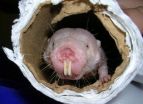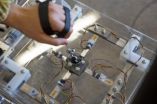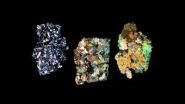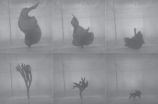(Press-News.org) SAN ANTONIO (May 10, 2012) — The typical naked mole rat lives 25 to 30 years, during which it shows little decline in activity, bone health, reproductive capacity and cognitive ability. What is the secret to this East African rodent's long, healthy life?
Scientists from the United States and Israel found a clue. From infancy to old age, naked mole rats are blessed with large amounts of a protein essential for normal brain function.
"Naked mole rats have the highest level of a growth factor called NRG-1 in the cerebellum. Its levels are sustained throughout their life, from development through adulthood," said Yael Edrey, doctoral student at The University of Texas Health Science Center San Antonio's Barshop Institute for Longevity and Aging Studies.
Comparison across 7 species
The Barshop Institute has the largest colony of naked mole rats in the U.S. — 2,000 rodents scampering around a network of tubes and cages in humid conditions that mimic their natural underground habitat. Edrey is the lead author of research that compared lifelong NRG-1 levels across seven species of rodents, from mice and guinea pigs to blind mole rats and Damaraland mole rats.
NRG-1 levels were monitored in naked mole rats at different ages ranging from 1 day to 26 years. The other six rodent species have maximum life spans of three to 19 years.
The cerebellum coordinates movements and maintains bodily equilibrium. The research team hypothesized that long-lived species would maintain higher levels of NRG-1 in this region of the brain, with simultaneous healthy activity levels.
Among each of the species, the longest-lived members exhibited the highest lifelong levels of NRG-1. The naked mole rat had the most robust and enduring supply. "In both mice and in humans, NRG-1 levels go down with age," Edrey said.
Protection of the brain
Researchers have documented various characteristics of naked mole rat physiology, revealing the integrity of proteins in the liver, kidney and muscle. This is the first set of data evaluating species' differences in a key factor involved in maintaining the integrity of the rodent's brain.
"The strong correlation between this protective brain factor and maximum life span highlights a new focus for aging research, further supporting earlier findings that it is not the amount of oxidative damage an organism encounters that determines species life span but rather that the protective mechanisms may be more important," said senior author Rochelle Buffenstein, Ph.D., professor of physiology and cellular and structural biology at the Barshop Institute. She is Edrey's research mentor.
The finding, while not directly applicable to humans, has many implications for NRG-1's role in maintaining neuron integrity.
Co-author Dorothée Huchon, Ph.D., a senior lecturer at Tel Aviv University in Israel, was a sabbatical scholar at the National Evolutionary Synthesis Center (NESCent) in Durham, N.C., during the project. Dr. Huchon conducted analyses revealing, she said, that the correlation between maximum life span and NRG-1 levels was independent of evolutionary lineage of the seven species.
Naked mole rats are burrowing rodents with a distinctive appearance — hairless with wrinkled pinkish skin, tiny eyes and protruding front teeth. Their native habitat is the Horn of Africa. The rodent's capacity to resist cancer and maintain protein integrity in the face of oxidative damage makes it an ideal animal model for aging and biomedical research.
INFORMATION:
The finding is described in an issue of Aging Cell.
On the Web and Twitter
For current news from the UT Health Science Center San Antonio, please visit our news release website or follow us on Twitter @uthscsa.
About the UT Health Science Center San Antonio
The University of Texas Health Science Center at San Antonio, one of the country's leading health sciences universities, ranks in the top 3 percent of all institutions worldwide receiving federal funding. Research and other sponsored program activity totaled $231 million in fiscal year 2011. The university's schools of medicine, nursing, dentistry, health professions and graduate biomedical sciences have produced approximately 28,000 graduates. The $736 million operating budget supports eight campuses in San Antonio, Laredo, Harlingen and Edinburg. For more information on the many ways "We make lives better®," visit www.uthscsa.edu.
Long-lived rodents have high levels of brain-protecting factor
2012-05-11
ELSE PRESS RELEASES FROM THIS DATE:
Helping Hands reaches out to patients with cerebral palsy
2012-05-11
HOUSTON – (May 9, 2012) – With the aid of multiple force sensors and a digital dinosaur, a team of Rice University seniors known as Helping Hands hopes to restore strength and flexibility to the hands and wrists of children with cerebral palsy.
"These kids have a real problem with their hands," said Jenna Desmarais, a senior at Rice majoring in mechanical engineering. "The fingers and wrists are locked into a sort of claw-like position. Even after surgery to correct it, they need physical therapy to get stronger."
The team's rehabilitation device, the Dino-Might, was ...
New twist on ancient math problem could improve medicine, microelectronics
2012-05-11
ANN ARBOR, Mich.—A hidden facet of a math problem that goes back to Sanskrit scrolls has just been exposed by nanotechnology researchers at the University of Michigan and the University of Connecticut.
It turns out we've been missing a version of the famous "packing problem," and its new guise could have implications for cancer treatment, secure wireless networks, microelectronics and demolitions, the researchers say.
Called the "filling problem," it seeks the best way to cover the inside of an object with a particular shape, such as filling a triangle with discs ...
ICU stays for worst asthma drop 74 percent, review finds
2012-05-11
SAN ANTONIO (May 10, 2012) — A review of 30 years of life-threatening asthma cases in a San Antonio intensive care unit found that annual ICU admissions for the condition have dropped 74 percent. The study, by UT Medicine San Antonio physicians who reviewed cases at University Hospital between 1980 and 2010, also showed intubation in the emergency department to help patients breathe did not result in longer hospital stays.
UT Medicine is the clinical practice of the School of Medicine at The University of Texas Health Science Center San Antonio.
Faculty studied inpatient ...
UF study finds logging of tropical forests needn't devastate environment
2012-05-11
GAINESVILLE, Fla. — Harvesting tropical forests for timber may not be the arch-enemy of conservation that it was once assumed to be, according to a new study led by a University of Florida researcher.
Selective logging may be one of the few feasible options left for conserving tropical forests given the huge financial incentives pushing tropical landholders to convert primary forests into cash-generating agricultural plantations.
The report analyzed data from more than 100 studies of tropical forests on three continents that had been harvested for timber. Results ...
CNIO researchers describe a new target for developing anti-angiogenic and anti-tumoral therapies
2012-05-11
Researchers from the Spanish National Cancer Research Centre (CNIO), led by Jorge L. Martínez-Torrecuadrada from the Proteomics Unit, have demonstrated that the antibody-based blocking of ephrinB2, a protein involved in angiogenesis and lymphoangiogenesis, may represent an effective strategy for the development of antiangiogenic and antitumoural therapies.
The results of this study appeared in this month's issue of Blood, the journal of the American Society of Hematology.
CNIO researchers generated highly-specific human antibodies against ephrin-B2 using a phage display ...
Nanotube 'sponge' has potential in oil spill cleanup
2012-05-11
A carbon nanotube sponge that can soak up oil in water with unparalleled efficiency has been developed with help from computational simulations performed at the Department of Energy's (DOE's) Oak Ridge National Laboratory.
Carbon nanotubes, which consist of atom-thick sheets of carbon rolled into cylinders, have captured scientific attention in recent decades because of their high strength, potential high conductivity and light weight. But producing nanotubes in bulk for specialized applications was often limited by difficulties in controlling the growth process as well ...
New report illustrates impact of sequestration to medical research
2012-05-11
The report "Sequestration: Health Research at the Breaking Point," released today by Research!America, demonstrates the damaging consequences of potential automatic spending cuts, or sequestration, to the nation's medical research enterprise and public health, and offers examples on how these cuts would delay scientific discoveries that could lead to new treatments and cures for deadly diseases.
This report provides:
The estimated budget cuts to the National Institutes of Health, the Centers for Disease Control and Prevention, the Agency for Healthcare Research and ...
Dawn reveals complexities of ancient asteroidal world
2012-05-11
TEMPE, Ariz. – New findings from NASA's Dawn spacecraft lay the groundwork for the first geological overview of asteroid (4)Vesta and confirm the existence of not one but two giant impact basins in its southern hemisphere. The findings, published today in a set of Science papers, will help scientists better understand the early solar system and processes that occurred as it formed and evolved.
The Dawn spacecraft, orbiting asteroid Vesta since July 2011, has already acquired several thousand images of the asteroid's surface, revealing a complex landscape. The images ...
Patients see benefits and risks to direct-to-consumer genetics tests
2012-05-11
MAYWOOD, Ill. – Patients see potential benefits from direct-to-consumer genetic testing, but are also concerned about how test results will be used, and generally are unwilling to pay more than $10 or $20 for them, according to focus groups conducted by researchers at Loyola University Chicago Stritch School of Medicine.
Findings by first author Katherine Wasson, PhD, MPH, and colleagues are published in the American Journal of Bioethics Primary Research. Wasson, an assistant professor in Loyola's Neiswanger Institute for Bioethics and Health Policy, is an expert on the ...
New research on seaweeds shows it takes more than being flexible to survive crashing waves
2012-05-11
Seaweeds are important foundational species that are vital both as food and habitat to many aquatic and terrestrial shore organisms. Yet seaweeds that cling to rocky shores are continually at risk of being broken or dislodged from their holds by crashing waves with large hydrodynamic forces. So how do such seaweeds survive in intertidal zones? Do they have special properties that make them extremely flexible or particularly strong?
Patrick Martone (University of British Columbia) has spent a considerable amount of time standing on the shore watching big waves crash ...



